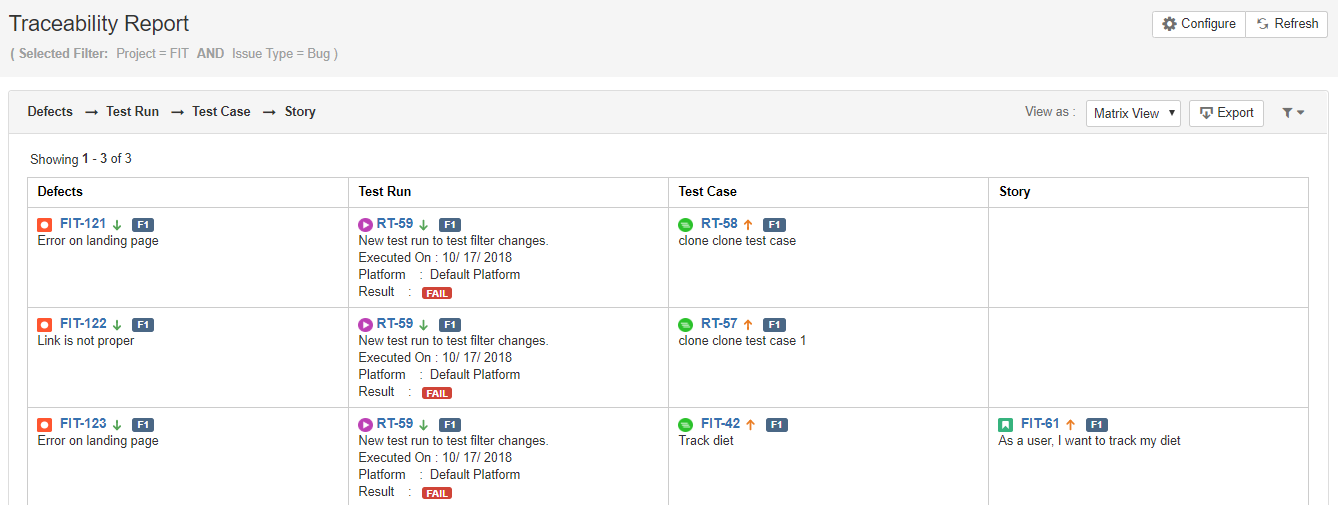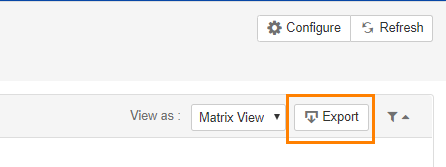Back to QMetry All Products Help Page
Traceability Report
Introduction
The Traceability Report enables you to trace how defects are discovered during executions. You can analyze the links between Defects, Test Cases and Stories, which helps you identify high risk Stories or Test Cases.
You can search for a specific test artifact and discover the web of its relationship with other artifacts. You can drill down into details by clicking on hyper links.
The report shows the hierarchy of issues (i.e. Story → Test Case → Test Run → Defect) within a single or multiple projects. It provides users -
- Flexibility to select the level to drill down the details
- Organized and detailed information
You can opt to drill down the report to the following hierarchy levels:
- Story - Test Case - Test Run - Defects
- Test Case - Story - Test Run - Defects
- Defects - Test Run - Test Case - Story
The report can be viewed with two different views:
- Matrix View
- Tree View
Configure Traceability Report
The report will be generated in accordance with the configuration.
Click on the Configure button at the top right corner.
The screen opens showing steps to configure the report.
- Select Report Hierarchy
- Issue Selection Option
- Select Issues or Criteria
Step 1. Select Report Hierarchy
You can select Story/Test Case/Defect to generate the report with relevant details. Select one of the following.
- Report hierarchy by Story: It displays report details in the hierarchy of Story - Test Case - Test Run - Defects.
- Report hierarchy Test Case: It displays report details in the hierarchy of Test Case - Story - Test Run - Defects.
- Report hierarchy by Defect: It displays report details in the hierarchy of Defects - Test Case - Test Run - Story.
By default, all the executions of Test Cases are shown in Traceability Hierarchy.
If you opt for only latest execution of Test Case, it will also include test case A-La-Carte execution i.e. test cases directly linked to test run instead of linking through story. Provided the same test case also exists in story.
Click Next.
Step 2. Issue Selection Option
Select either of the following options:
(A) By Filter Criteria like Project, Issue Type, Issue Status or JQL: Apply different filter or write JQL query to construct issue selection criteria.
Note: This option will update report dynamically if new issues are added matching the selection criteria.
Once the query/criteria is constructed for issue selection, users need not to bother about writing new queries/criteria to take care of any changes/addition/removal of issues. It will be taken care of automatically.
To search issues with specific criteria, you can apply either Basic Search or Advanced Search.
Basic Search:
- Project
- Issue Type (except Hierarchy by Test Case)
- Status: Select the Issue Status – To Do, In Progress, Done.
- Search By: You can search issues either with Issue Key or with Summary. Just select the parameter and enter value in the adjacent search box.
Advanced Search:
You can use JQL to write the search query and get preferred issues as per the criteria.
(B) Individual Issues
Check box will be available to select individual issues as per your preference.
Step 3. Select Issues or Criteria
Once you select either of the options above, the next screen displays list of issues accordingly.
Either apply Filter criteria to filter the required issues or select individual issues you want to include in generating the report.
Click on the Generate Report button at top.
View Traceability Report
The next screen opens with the report details, which can be viewed either in Tree View or in Matrix View.
You can search issues with their Issue Type, filter the records in the report on the basis of Execution Result of test cases and segregate issues with bugs.
Users can search issues by its Type and either Summary or Issue ID.
For example,
(1) If you want to check a particular defect is linked with how many test runs, then -
- Search by “Defects”
- Enter either Summary or Issue ID in the search box.
- The results you get will show the defect association with multiple test runs.
(2) If you want to know which test cases are covered under a particular test run, then -
- Search by “Test Run”
- Enter either Summary or Issue ID in the search box.
- The results you get will show the test run association with multiple test cases.
(3)If you want to know which test runs are covered under a particular test case, then -
- Search by “Test Case”
- Enter either Summary or Issue ID in the search box.
- The results you get will show the test case association with multiple test runs.
There are two views available to view the report:
- Tree View
- Matrix View
Tree View
All the levels Story, Test Case, and Test Run are expandable and you can be drill down to defects in tree structure.
Issue Keys are clickable, clicking on which opens relevant issue in a separate page.
Hierarchy By Story
Hierarchy By Test Case
Hierarchy By Defect
Matrix View
You can view the report in table format. The parent - child relation of artifacts (Stories, Test Cases, Test Runs and Defects) is clearly visible in this format without hampering the view.
Issue Keys are clickable, clicking on which opens relevant issue in a separate page.
The Matrix View displays additional information of Platform and Executed On for Test Runs.
Export Traceability Report
You can export the Traceability Report data to Excel for further analysis and comparison. To export the report details in Excel, click on the Export button at right.
It will export all the records irrespective of pagination on the screen.








